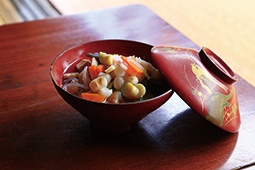INDEX

Brewers grind the yeast starter using the traditional yamaoroshi technique 

Two specialties of Fukushima: Ika ninjin and kozuyu 
Éric Briffard, Executive Chef at Le Cordon Bleu Paris, pairs sake with French food at the 2019 "Taste of Paris” festival
May 2020
Sake: Created Naturally with the Wisdom of Brewmasters

Fukushima Prefecture is home to many famous and long-standing sakagura, or Japanese sake breweries. We interviewed the 10th-generation head of one sakagura to learn about the tradition of sake brewing in Fukushima and how local brewmasters’ wisdom is being passed down to future generations.

Sake production in present-day Fukushima Prefecture is said to have started over 300 years ago under the Aizu Domain. The Aizu region is surrounded by mountains, the snowcapped peaks of which are the source of pure, mineral-rich water that is well suited both for the production of sake and the cultivation of rice from which sake is brewed. The climate is also quite cold, preventing the growth of unwanted bacteria that lower the quality of sake. Sake breweries, or sakagura, soon opened up in areas around Aizu as well, creating a center of sake production in Japan. The brewing tradition continues in Fukushima, where over sixty sakagura are currently producing sake.
Fukushima has many traditional dishes that pair well with sake, and one of the biggest draws to the prefecture is the ability to enjoy sake together with these local foods. Examples include kozuyu (also called zakuzaku), lots of vegetables in a broth made from dried scallops; ika ninjin, thinly sliced dried squid mixed with carrots; and anpo gaki, sweet jelly-like dried persimmons.

“What makes the sake of Fukushima Prefecture special is that the various sakagura – from long-established breweries to new ones – make a wide variety of sake, each using their own methods. Someone once commented, ‘Fukushima is like a department store of sake.’”
So says Ohta Hideharu, the 10th-generation head of Daishichi Sake Brewery Co., Ltd. which is located in the city of Nihonmatsu in central Fukushima. Established in 1752, the brewery is one of the long-standing sakagura representative of Fukushima Prefecture and one of the very few in Japan still to use the “kimoto method” of sake brewing.
The kimoto method, which was developed during the Edo period (1603–1867), is what makes the Daishichi Sake Brewery’s sake special. In sake production, there is a process for creating “moto” (yeast starter) containing large quantities of yeast required for fermenting alcohol. At the Daishichi Sake Brewery, steamed rice, koji and water are mixed inside a shallow tub, and sake brewers perform a job called yamaoroshi, in which they grind the mixture into a mash using long wooden paddles. Lactic acid bacteria, which exist within the brewery, are then naturally incorporated into the moto, where they start producing lactic acid. This sour environment dispels all other unwanted microorganisms, so that the yeast, after it has been added, can proliferate in a clean and pure environment. This production method requires much time and effort, but the sake created using it has a soft, smooth flavor that is bursting with umami.


Daishichi Sake Brewery’s sake has received high praise both in Japan and abroad for pairing well not only with Japanese food, but with French, Chinese and other international foods as well. The sake has been served at banquets hosted by the Dutch royal family, as well as at the 2000 Kyushu-Okinawa Summit and the 2008 Hokkaido Toyako Summit.
“The skills of sake brewers, which have been passed down over many years, bring out the power held in natural microorganisms, leading to the creation of sake with deep flavors,” says Ohta.
The sake of Fukushima Prefecture is highly evaluated by connoisseurs. At the Annual Japan Sake Award, for example, brands from Fukushima received more Gold Awards than any other prefecture for seven years in a row, up until 2018. Their popularity and success owes partly to the influence of the Fukushima Prefectural Sake Academy, which opened in 1992 offering a three-year course in all aspects of sake production. The Academy is operated by the Fukushima Prefecture Sake Brewers Cooperative and many of its graduates are active as sake brewers in the prefecture.

“The improvement in the quality of Fukushima’s sake is the result of many years of personnel development,” says Ohta. “Fellow graduates of the Sake Academy raise each other’s technical level while working hard. Fukushima suffered harmful rumors due to the Great East Japan Earthquake, but through cooperating and producing even more delicious sake, the sakagura were able to regain customers’ trust. We will also overcome the novel coronavirus crisis through everyone’s efforts.”

